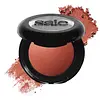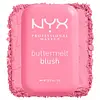What's inside
What's inside
 Key Ingredients
Key Ingredients

 Benefits
Benefits

 Concerns
Concerns

 Ingredients Side-by-side
Ingredients Side-by-side

Mica
Cosmetic ColorantSynthetic Fluorphlogopite
Kaolin
AbrasiveSqualane
EmollientJojoba Esters
EmollientOctyldodecanol
EmollientHectorite
AbsorbentSilica
AbrasiveEthylhexylglycerin
Skin ConditioningPotassium Sorbate
PreservativeAlumina
AbrasiveBoron Nitride
AbsorbentCellulose
AbsorbentGlycerin
HumectantSodium Acetylated Hyaluronate
HumectantWater
Skin ConditioningTocopherol
AntioxidantGlycyrrhiza Glabra Root Extract
BleachingSodium Benzoate
MaskingCI 77491
Cosmetic ColorantCI 77492
Cosmetic ColorantCI 77499
Cosmetic ColorantCI 77163
Cosmetic ColorantCI 77007
Cosmetic ColorantCI 15850
Cosmetic ColorantCI 45410
Cosmetic ColorantCI 77891
Cosmetic ColorantMica, Synthetic Fluorphlogopite, Kaolin, Squalane, Jojoba Esters, Octyldodecanol, Hectorite, Silica, Ethylhexylglycerin, Potassium Sorbate, Alumina, Boron Nitride, Cellulose, Glycerin, Sodium Acetylated Hyaluronate, Water, Tocopherol, Glycyrrhiza Glabra Root Extract, Sodium Benzoate, CI 77491, CI 77492, CI 77499, CI 77163, CI 77007, CI 15850, CI 45410, CI 77891
Mica
Cosmetic ColorantCI 77891
Cosmetic ColorantTalc
AbrasiveSilica
AbrasiveLauroyl Lysine
Skin ConditioningTrimethylsiloxyphenyl Dimethicone
Ethylhexyl Palmitate
EmollientZinc Stearate
Cosmetic ColorantCI 15850
Cosmetic ColorantCI 45410
Cosmetic ColorantOctyldodecanol
EmollientMangifera Indica Seed Butter
Skin ConditioningHelianthus Annuus Seed Oil
EmollientPrunus Amygdalus Dulcis Oil
Skin ConditioningButyrospermum Parkii Butter
Skin ConditioningAroma
Caprylyl Glycol
EmollientIsostearyl Isostearate
EmollientOctyldodecyl Stearoyl Stearate
EmollientTocopherol
AntioxidantPhenoxyethanol
PreservativeLinalool
PerfumingLimonene
PerfumingMica, CI 77891, Talc, Silica, Lauroyl Lysine, Trimethylsiloxyphenyl Dimethicone, Ethylhexyl Palmitate, Zinc Stearate, CI 15850, CI 45410, Octyldodecanol, Mangifera Indica Seed Butter, Helianthus Annuus Seed Oil, Prunus Amygdalus Dulcis Oil, Butyrospermum Parkii Butter, Aroma, Caprylyl Glycol, Isostearyl Isostearate, Octyldodecyl Stearoyl Stearate, Tocopherol, Phenoxyethanol, Linalool, Limonene
 Reviews
Reviews

Ingredients Explained
These ingredients are found in both products.
Ingredients higher up in an ingredient list are typically present in a larger amount.
Ci 15850 is the pigment color red. It is an azo dye and created synthetically.
Azo dyes need to be thoroughly purified before use. This allows them to be more stable and longer-lasting.
This ingredient is common in foundations, lipsticks, and blushes. This color is described as brown/orangey red.
It has many secondary names such as Red 6 and Red 7. According to a manufacturer, Red 6 usually contains aluminum.
Learn more about CI 15850CI 45410 is a synthetic red-pigment and dye.
It often goes by both Red 28 or Red 27; manufacturers label both ingredients as CI 45410.
This dye is commonly found in makeup because it imparts a vivid color. Some types of this dye change color based on pH level and interaction with moisture:
Your skin has a natural pH of around 4.5 - 5.5.
According to the FDA, CI 45410 is not permitted for use in eye products.
Red 27 is a flourescein dye and commonly used as a fluorescent tracer in medicine.
Learn more about CI 45410Ci 77891 is a white pigment from Titanium dioxide. It is naturally found in minerals such as rutile and ilmenite.
It's main function is to add a white color to cosmetics. It can also be mixed with other colors to create different shades.
Ci 77891 is commonly found in sunscreens due to its ability to block UV rays.
Learn more about CI 77891Mica is a naturally occurring mineral used to add shimmer and color in cosmetics. It can also help improve the texture of a product or give it an opaque, white/silver color.
Serecite is the name for very fine but ragged grains of mica.
This ingredient is often coated with metal oxides like titanium dioxide. Trace amounts of heavy metals may be found in mica, but these metals are not harmful in our personal products.
Mica has been used since prehistoric times throughout the world. Ancient Egyptian, Indian, Greek, Roman, Aztec, and Chinese civilizations have used mica.
Learn more about MicaOctyldodecanol is a fatty alcohol. It is primarily used to enhance the texture of products.
As an emulsifier, Octyldodecanol helps prevent the oils and waters from separating. It also prevents ingredients from creating foam when shaken.
Octyldodecanol is created by reducing fatty acid to an alcohol.
Due to its high molecular weight, it does not get absorbed into the skin.
Learn more about OctyldodecanolSilica, also known as silicon dioxide, is a naturally occurring mineral. It is used as a fine, spherical, and porous powder in cosmetics.
Though it has exfoliant properties, the function of silica varies depending on the product.
The unique structure of silica enhances the spreadability and adds smoothness, making it a great texture enhancer.
It is also used as an active carrier, emulsifier, and mattifier due to its ability to absorb excess oil.
In some products, tiny microneedles called spicules are made from silica or hydrolyzed sponge. When you rub them in, they lightly polish away dead skin layers and enhance the penetration of active ingredients.
Learn more about SilicaTocopherol (also known as Vitamin E) is a common antioxidant used to help protect the skin from free-radicals and strengthen the skin barrier. It's also fat soluble - this means our skin is great at absorbing it.
Vitamin E also helps keep your natural skin lipids healthy. Your lipid skin barrier naturally consists of lipids, ceramides, and fatty acids. Vitamin E offers extra protection for your skin’s lipid barrier, keeping your skin healthy and nourished.
Another benefit is a bit of UV protection. Vitamin E helps reduce the damage caused by UVB rays. (It should not replace your sunscreen). Combining it with Vitamin C can decrease sunburned cells and hyperpigmentation after UV exposure.
You might have noticed Vitamin E + C often paired together. This is because it is great at stabilizing Vitamin C. Using the two together helps increase the effectiveness of both ingredients.
There are often claims that Vitamin E can reduce/prevent scarring, but these claims haven't been confirmed by scientific research.
Learn more about Tocopherol